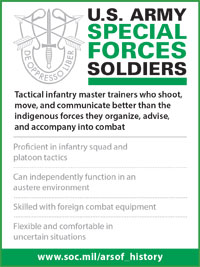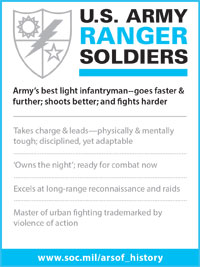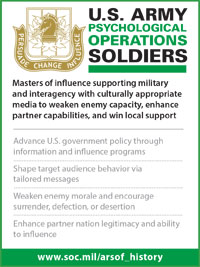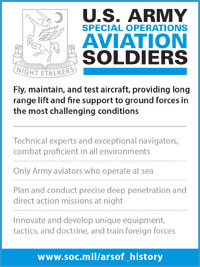How does an ARSOF soldier concisely explain his/her capabilities to another soldier or, harder still, to a potential recruit in ‘non-militareeze,’ without acronyms and ‘buzz’ terminology, in fewer than 50 words, within 8 seconds, to meet the average attention span of the Generation Y and Z? What defines him/her as an ARSOF soldier specialist? What are the ‘bare minimums’ that this ARSOF soldier ‘will bring to the table’? Are those ‘minimums’ different for officers, warrant officers, sergeants, and enlisted soldiers? This is a difficult challenge for serving ARSOF soldiers, as it was for our veterans.
When President John F. Kennedy promoted Army Special Forces as America’s counter-insurgency specialists, and distinguished them as elite with the Green Beret on 12 October 1961, the Special Warfare Center (SWC) had not codified basic credentials of an SF soldier. Neither had its predecessor, the Psychological Warfare (Psywar) Center, done this for Psywar soldiers. The SF were to organize, train, and advise indigenous guerrilla infantry units, but what specific level of infantry (‘shoot, move, and communicate’) expertise was required? Was it different for officers than non-commissioned officers (NCOs)?

The 1959 “Code of the Special Forces Operator” was a pledge to abide by the Code of Conduct, and an understanding that he was volunteering to be deployed behind enemy lines to organize, train, and exploit guerrilla forces, and realized the hazards involved. He would not tarnish the honor of his team, service, or country. The SF Operator pledged to keep himself mentally and physically fit at all times. He understood that language and specialist training was required, and that he would “undergo more intense and more rugged training than is required of the average soldier of the United States Army.”1 The SF Operator further pledged “to remain in Special Forces for a minimum of six years.”2 And, he acknowledged that a “failure to achieve satisfactory progress in training, demonstration of poor judgment, immaturity or misconduct of such a nature as to bring discredit on [himself] or Special Forces, [would] be proper cause for immediate reassignment and a permanent bar from future duty with Special Forces.”3 Specific standards were not addressed.






